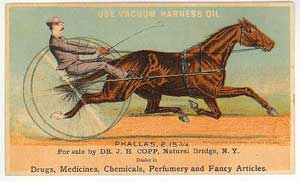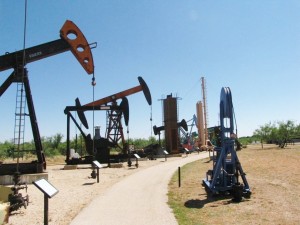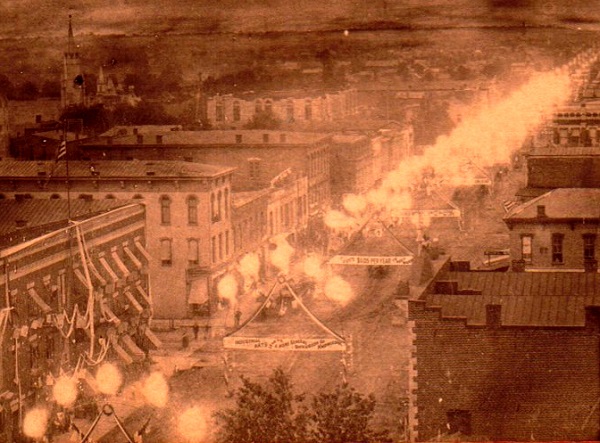September 10, 1969 – Second Nuclear Fracturing Test –
A 40-kiloton nuclear device was detonated about eight miles southeast of present-day Parachute, in Garfield County, Colorado. Project Rulison was the second of three natural-gas-reservoir stimulation tests that were part of Operation Plowshare, a government program to study uses of nuclear explosives for peaceful purposes.
The first nuclear fracturing test, Project Gasbuggy, detonated a 29-kiloton device in a New Mexico well in December 1967. The third unconventional test to increase production was Project Rio Blanco, a 1973 detonation in a Rio Blanco County, Colorado, natural gas well.
September 11, 1960 – Houston Oilers feature Derricks on Helmets
The first game of the new American Football League’s Houston Oilers featured a helmet with oil derricks representing the franchise. The design and team colors were selected by owner Bud Adams, whose father, Kenneth “Boots” Adams succeeded Frank Phillips in 1930 as president of Phillips Petroleum Company until retiring in 1968.

Houston Oilers helmet logos included a prototype with gusher (used only in advertising), the inaugural white derrick (1960-1965), and a multicolor variation (1966-1998) until the franchise moved to Nashville. Photographs courtesy Helmet Hut and eBay.
Adams and Lamar Hunt, founder of the Dallas Texans franchise, now the Kansas City Chiefs, established the new league in 1959. Hunt’s father, independent producer Haroldson “H.L.” Hunt Jr., had found great success in Arkansas oilfields — and the giant East Texas field. An early prototype Oilers helmet logo included the derricks gushing oil, “a reminder to the roots of the Oilers beginnings in Houston,” notes Helmut Hut.
September 11, 1866 – Distilling Kerosene in Vacuum leads to Mobil Oil
Carpenter and inventor Matthew Ewing patented a new method for distilling kerosene in a vacuum to produce lubricants. His innovation would lead to Mobil Oil. Three weeks after receiving his patent, Ewing and partner Hiram Everest founded the Vacuum Oil Company in Rochester, New York. Their first product was “Ewing’s Patent Vacuum Oil,” a leather conditioner.

Beginning in 1866, “Ewing’s Patent Vacuum Oil” preserved and lubricated leather harnesses.
After Ewing left the partnership, Everest improved the refining process and distributed the lubricant in square containers previously used for canned oysters. In 1880, Everest sold 75 percent interest in Vacuum Oil to John D. Rockefeller’s Standard Oil Company. Vacuum Oil became an industry pioneer of lubricant products, including Gargoyle Steam Cylinder Oil, before evolving into Socony Mobil in 1955, then Mobil Oil, before becoming ExxonMobil in 1999.
Learn more in Mobil’s High-Flying Trademark.
September 12, 1866 – First Texas Oil Well
The Texas petroleum industry began when Lyne Taliaferro Barret’s Melrose Petroleum Oil Company completed a well east of Nacogdoches producing 10 barrels of oil per day.

Lyne Taliaferro Barret in 1859 leased 280 acres east of Nacogdoches, Texas, to drill in an area known for natural oil seeps.
The Confederate Army veteran’s No. 1 Isaac C. Skillern well, drilled in an area known as Oil Springs, found the newly prized resource at a depth of 106 feet. The well’s modest oil production and limited access to markets led to the failure of Melrose Petroleum Oil Company.
The oilfield Barret discovered lay dormant for nearly two decades until exploration continued near his well. With oil production then lasting into the 1950s, the Nacogdoches field became the oldest oilfield in the Lone Star State.
Learn more in First Texas Oil Well.
September 13, 1975 – President dedicates Petroleum Museum
President Gerald R. Ford addressed 400 guests attending the opening ceremony for the Permian Basin Petroleum Museum, Library and Hall of Fame in Midland, Texas. After touring the museum, he was presented with “Dressing the Bit,” a 15-inch bronze sculpture of two cable-tool workers.

President Gerald Ford spoke at the Petroleum Museum’s 1975 opening in Midland, Texas. Photo courtesy Petroleum Museum.
The oil museum, which received an $18 million renovation in 2016, maintains more than 60,000 square feet of space for geological, technical, and cultural exhibits. Outdoor exhibits include drilling rigs, pumping units and other oilfield machinery. The museum also preserves the world’s largest collection of Chaparral racing cars.

“Dressing the Bit,” by Lincoln H. Fox. Photo courtesy Gerald R. Ford Presidential Museum.
Energy education programs include K-6 robotics courses, an engineering “fun lab,” traveling trunks for school visits, and family science nights. The Permian Basin Petroleum Museum offers a journey through 230 million years of history.
September 13, 1957 – First Hawaiian Refinery
Standard Oil of California announced it would build the Territory of Hawaii’s first and only oil refinery, eight miles west of Pearl Harbor. According to a 1959 Popular Mechanics article, Standard Oil originally planned to import petroleum from the Middle East “by means of an unusual undersea submarine cable.” In 2016, Chevron in sold the facility to Island Energy Services LLC. Par Hawaii currently operates the refinery in the Honolulu port area of Oahu, processing about 94,000 barrels of crude oil a day.
September 14, 1871 – President Grant visits Pennsylvania Oil Region
President Ulysses S. Grant and his family arrived at Titusville, Pennsylvania, on a special train. The 18th president thanked residents for the reception and noted it was his first visit to the oil regions, adding, “I am aware that this section of the country furnished its full share of men and means for suppression of the rebellion, and your efforts in the discovery and production of petroleum aided materially in supplying the sinews of war, as a medium of foreign exchange, taking the place of cotton.”

“This 1865 photograph shows the U.S. Grant oil well at Pithole, Pennsylvania. The well was presumably named after the Union Army’s top general in the Civil War,” notes the Oil Region Library Association.
According to the Oil Region Library Association, “Grant spoke to oil producers at the Oil Exchange, enjoyed lunch at the Duncan House and then headed via train to Reno, where he stopped to witness a gushing oil well.” President Grant observed the scene with “silent astonishment,” noted the local newspaper.
President Grant’s oil regions trip included visits to Petroleum Centre, Oil City, Franklin, and Pittsburgh. In 1876, seeking to improve roads in the nation’s capital, he directed that Pennsylvania Avenue be paved (see Asphalt Paves the Way).
September 14, 1929 – West Texas Well sets Record
A West Texas well struck oil at a depth of 1,070 feet and produced an astounding 204,672 barrels of oil a day — the nation’s most productive single well up until that time. The Yates 30-A initially produced 8,528 barrels of oil per hour, according to the Handbook of Texas Online.
The Pecos County well was drilled just a few hundred yards from the 1926 discovery well of the giant Yates field, the Ira G. Yates 1-A.

The Yates field has been producing continuously since the 1920s. Pecos County alone covers more than 4,700 square miles. Photo courtesy of the Houston Chronicle.
First discovered in 1920, the Permian Basin’s massive size had been confirmed in 1923 by the Santa Rita No. 1 well. The Yates 30-A well, operated by Transcontinental Oil Company and Mid-Kansas Oil and Gas Company (then a subsidiary of the Ohio Oil Company) brought an oil boom to Midland and Odessa.
The Yates oilfield produced its one-billionth barrel of oil in 1985. “The Yates field, among the largest ever found in the United States, has been in continuous production for 85 years and has been exploited by a list of oil companies, some of them no longer in existence,” noted the Houston Chronicle in 2011.
September 14, 1960 – OPEC founded in Baghdad
The Organization of the Petroleum Exporting Countries (OPEC) was created at the Baghdad Conference by Iran, Iraq, Kuwait, Saudi Arabia and Venezuela (later joined by nine other countries). Headquartered in Vienna, Austria, since 1965, OPEC’s stated objectives were to “coordinate and unify petroleum policies among member countries in order to secure fair and stable prices for petroleum producers; an efficient, economic and regular supply of petroleum to consuming nations; and a fair return on capital to those investing in the industry.”
September 15, 1886 – Trenton Field brings Indiana Natural Gas Boom
When natural gas discoveries in Ohio excited speculation in Indiana, a group of investors established the Eaton Mining & Gas Company. They were rewarded when the company’s first well found natural gas. Unknown at the time, the 920-foot-deep well in east central Indiana had discovered the 5,120-square-mile Trenton gas field.

Cities in Indiana and Ohio erected “flambeaux” arches to attract new industries. Indiana banned them in 1891, an early effort to legislate conservation. Photo of Findlay, Ohio, during its 1888 Gas Jubilee courtesy Hancock Historical Museum.
Spreading over 17 Indiana counties and into Ohio, the field became the largest in the world by the 1880s. Industrialist Andrew Carnegie proclaimed natural gas replaced 10,000 tons of coal a day for making steel as new pipelines attracted manufacturing industries — until profligate waste exhausted much of Indiana’s natural gas by the early 1900s.
Learn more in Indiana Natural Gas Boom.
September 15, 1903 – Improved Portable Drilling Machine Patented
Seth Powers of Stanberry, Missouri, received a patent for his “Combined Well Boring and Rock Drilling Machine.” The wheel-mounted, cable-tool framework — used primarily for water wells but capable of finding oil — included a derrick, steam engine, and boring augers.

Seth Powers manufactured a portable drilling rig for boring deeper wells. Image courtesy Superstition Mountain Museum.
Lisle Manufacturing Company promoted the improved technology as a “One-Man Machine” for boring deep wells. By World War I, the company offered a complete line of portable drilling machines, which could bore up to 1,000 feet deep with the gasoline-powered model.
The Superstition Mountain Museum east of Phoenix, Arizona, preserves an original 1903 version of the Improved Powers Well Boring Machine.
_______________________
Recommended Reading: Project Plowshare: The Peaceful Use of Nuclear Explosives in Cold War America (2012); Smithsonian ExxonMobil Historical Collection, 1790-2004 (2014); Nacogdoches, Images of America
(2009); Midland, Images of America
(2010); Yates: A family, A Company, and Some Cornfield Geology
(2000); Desert Kingdoms to Global Powers: The Rise of the Arab Gulf (2016); The Extraction State, A History of Natural Gas in America (2021); Natural Gas for the Hoosier State
(1995); Drilling Technology in Nontechnical Language
(2012). Your Amazon purchase benefits the American Oil & Gas Historical Society. As an Amazon Associate, AOGHS earns a commission from qualifying purchases.
_______________________
The American Oil & Gas Historical Society (AOGHS) preserves U.S. petroleum history. Please become an AOGHS annual supporter and help maintain this energy education website and expand historical research. For more information, contact bawells@aoghs.org. Copyright © 2024 Bruce A. Wells. All rights reserved.



